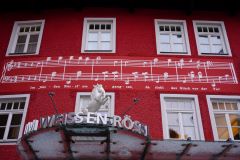Bad Ischl in the Salzkammergut: European Capital of Culture and musical hotspot
Thursday, May 16, 2024

Alongside Tartu in Estonia and Bodø in Norway, Bad Ischl is this year’s European Capital of Culture. The title turns the spotlight not only on Ischl itself, but on the entire Salzkammergut region extending across three Austrian federal states: Upper Austria, Salzburg, and Styria. Putting aside the broader cultural implications, this text concentrates on the musical aspects of the region’s culture, with special reference to RISM projects that were based there.
During the golden era of Viennese operetta from around 1860 to 1940 and beyond, Ischl was considered a hotspot for this genre. The town was a favorite summer resort not only for the Viennese court but also for the best-known composers of the time: Johannes Brahms, Anton Bruckner, Johann Strauss the Younger, Franz Lehár, Leo Fall, Oscar Straus, and Emmerich Kálmán, to name but a few. During the long summer months, they all took the opportunity to focus on their creative work. Lehár for one was particularly fond of Ischl. In 1910, he bought a villa there, to which he returned every summer, also to compose several works.
The RISM database contains descriptions of musical sources from seven different libraries and archives in the Salzkammergut region: A-ALT, A-ISCHlv, A-ISCHsta, A-GMUp, A-HSm, A-MO, A-SCHA. Particularly noteworthy are the two Ischl collections at the City Office (A-ISCHsta, 107 records) and the Lehár Villa (A-ISCHlv, 803 records), respectively, featuring sources from the estate of Franz Lehár. As RISM reported at the time, this cataloging project was completed in 2020 by Sandra Föger.
The collection kept in the parish of Schörfling am Attersee (A-SCHA) is represented in RISM with 609 entries of sacred vocal music. Most of the sources date from the period after around 1850. The Hallstatt Museum (A-HSm) owns a smaller, rather mixed collection with 275 RISM entries from both reputed and lesser-known composers. Here, too, most of the sources date from the mid-19th century onwards.
In Central Europe the arguably most popular piece of music associated with the Salzkammergut region is “Im Salzkammergut da kann man gut lustig sein,” which has often been sung in both its original form and with diverse parody texts. The original piece formed part of Ralph Benatzky’s Singspiel “Im weißen Rössl,” first performed in Berlin on 8 November 1930. A number of arranged excerpts from this singspiel can also be found in our database (RISM Catalog | RISM Online).
Image: Hotel Im Weißen Rössl, St. Wolfgang im Salzkammergut. Photography by Ray Swi-hymn from Sijhih-Taipei, Taiwan, CC BY-SA 2.0, via Wikimedia Commons
Share Tweet EmailCatégorie: A la une

